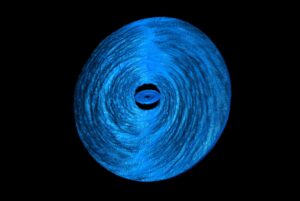New finding might explain why quasars flare and fade so quickly

New high-resolution simulations show that the violent whirlpool of gas that encircles a supermassive black hole breaks apart into inner and outer rings.
A new Northwestern University-led study is changing the way astrophysicists understand the eating habits of supermassive black holes.
While previous researchers have hypothesized that black holes eat slowly, new simulations indicate that black holes scarf food much faster than conventional understanding suggests.
The study was published on September 20, 2023 in The Astrophysical Journal.
According to new high-resolution 3D simulations, spinning black holes twist up the surrounding space-time, ultimately ripping apart the violent whirlpool of gas (or accretion disk) that encircles and feeds them. This results in the disk tearing into inner and outer subdisks. Black holes first devour the inner ring. Then, debris from the outer subdisk spills inward to refill the gap left behind by the wholly consumed inner ring, and the eating process repeats.
One cycle of the endlessly repeating eat-refill-eat process takes mere months — a shockingly fast timescale compared to the hundreds of years that researchers previously proposed.
This new finding could help explain the dramatic behavior of some of the brightest objects in the night sky, including quasars, which abruptly flare up and then vanish without explanation.
“Classical accretion disk theory predicts that the disk evolves slowly,” said Northwestern’s Nick Kaaz, who led the study. “But some quasars — which result from black holes eating gas from their accretion disks — appear to drastically change over time scales of months to years. This variation is so drastic. It looks like the inner part of the disk — where most of the light comes from — gets destroyed and then replenished. Classical accretion disk theory cannot explain this drastic variation. But the phenomena we see in our simulations potentially could explain this. The quick brightening and dimming are consistent with the inner regions of the disk being destroyed.”
Kaaz is a graduate student in astronomy at Northwestern’s Weinberg College of Arts and Sciences and member of the Center for Interdisciplinary Exploration and Research in Astrophysics (CIERA). Kaaz is advised by paper co-author Alexander Tchekhovskoy, an associate professor of physics and astronomy at Weinberg and a CIERA member.
Continue to the full Northwestern News story.

